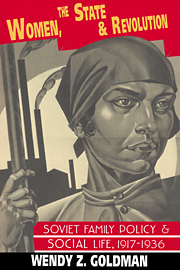Book contents
- Frontmatter
- Contents
- List of tables
- Acknowledgments
- 1 The origins of the Bolshevik vision: Love unfettered, women free
- 2 The first retreat: Besprizornost' and socialized child rearing
- 3 Law and life collide: Free union and the wage-earning population
- 4 Stirring the sea of peasant stagnation
- 5 Pruning the “bourgeois thicket”: Drafting a new Family Code
- 6 Sexual freedom or social chaos: The debate on the 1926 Code
- 7 Controlling reproduction: Women versus the state
- 8 Recasting the vision: The resurrection of the family
- Conclusion: Stalin's oxymorons: Socialist state, law, and family
- Index
- Soviet and East European Studies
Conclusion: Stalin's oxymorons: Socialist state, law, and family
Published online by Cambridge University Press: 26 March 2010
- Frontmatter
- Contents
- List of tables
- Acknowledgments
- 1 The origins of the Bolshevik vision: Love unfettered, women free
- 2 The first retreat: Besprizornost' and socialized child rearing
- 3 Law and life collide: Free union and the wage-earning population
- 4 Stirring the sea of peasant stagnation
- 5 Pruning the “bourgeois thicket”: Drafting a new Family Code
- 6 Sexual freedom or social chaos: The debate on the 1926 Code
- 7 Controlling reproduction: Women versus the state
- 8 Recasting the vision: The resurrection of the family
- Conclusion: Stalin's oxymorons: Socialist state, law, and family
- Index
- Soviet and East European Studies
Summary
We should not aspire to a highly stable family and look at marriage from that angle. Strengthening marriage and the family – making divorce more difficult – is not new, it is old: it is the same as bourgeois law.
Iakov Brandenburgskii, arguing before the VTsIK in 1925These “theories” were reflected also in denial of the socialist character of Soviet law, in attempts to portray Soviet law as bourgeois law – as law resting on the same bourgeois principles and expressing the same social relationships inherent in the bourgeois order. These persons trod the well worn path of Trotskyite-Bukharinist perversions…
Andrei la. Vyshinskii, 1948In the two decades between 1917 and 1936, the official Soviet view of the family underwent a complete reversal. Beginning with a fierce, libertarian commitment to individual freedom and “the withering away” of the family, the period ended with a policy based on a repressive strengthening of the family unit. Similar shifts occurred in the ideology of the state and the law as the Party systematically eliminated the libertarian currents in Bolshevik thought. A legal understanding of crime based on social causation and rehabilitation yielded to a new emphasis on personal culpability and punishment. Open intellectual exchange gave way to fearful caution, honest debate to a stiff, brittle mockery of discussion. By 1936, newspapers trumpeted support for a strong socialist family, elaborate legal codes, and a powerful state. The concepts of socialist family, law, and state, more reminiscent of Constantine Pobedonostsev than Marx, had become the new holy trinity of the Party.
- Type
- Chapter
- Information
- Women, the State and RevolutionSoviet Family Policy and Social Life, 1917–1936, pp. 337 - 344Publisher: Cambridge University PressPrint publication year: 1993

